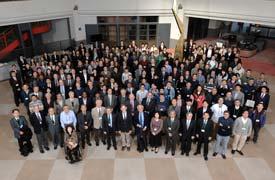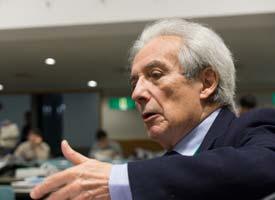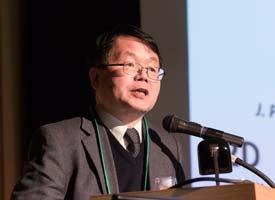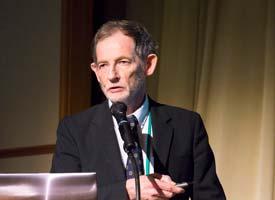

03/27/2017

Some big ideas take generations to gain a foothold, especially when they challenge the established order. But it took only a few years for the Advanced Institute for Materials Research (AIMR) to bring mathematics into the fold of materials science.
Held on the AIMR’s tenth anniversary, the AIMR International Symposium (AMIS) 2017 celebrated this remarkable achievement. Congratulations echoed throughout the five-day event, including from Nobel laureate Albert Fert, Japanese materials science star Hideo Hosono and world-renowned applied mathematician Sir John Ball. “Mathematics has transformed the scientific scene,” said AIMR Director Motoko Kotani, who has led the effort.
When Tohoku University decided in 2007 to assemble a ‘dream team’ of materials scientists from diverse backgrounds, it had a century of success in traditional approaches to materials research behind it. The AIMR was established to find new ways of controlling atoms and molecules by bringing together physicists, chemists and engineers in one place.
Five years later, Kotani, as the new AIMR director, reframed the institution’s goals in the language of maths. She little expected that maths would revitalize the field of materials science so rapidly. She laid out a conservative timeframe for results to emerge. “I envisioned it as a long-term investment.” But within two years, experimentalists and theorists at the AIMR had solved a problem that had dogged materials scientists for 50 years — the atomic structure of amorphous materials such as glasses. They found that atoms in metallic glasses form 20-sided geometric shapes known as icosahedrons. This prevents crystal structures from forming because, unlike other polyhedra such as cubes and tetrahedrons, icosahedrons cannot be packed together in a regular array such that there are no gaps.
The idea that scientists can find common ground in maths is not entirely new, but the AIMR resurrected it in a modern context. “The mathematicians that we all revere — Newton, Cauchy, Riemann — didn’t distinguish between pure and applied mathematics. They saw it all as one spectrum,” said Ball, Sedleian professor of natural philosophy at the University of Oxford and former president of the International Mathematical Union, who was invited to speak at AMIS2017. As long ago as 1623, Galileo Galilei described the Universe as a “grand book”, written in the language of maths, “without which one wanders in vain through a dark labyrinth.”
“Somehow at the beginning of the 20th century, things got very polarized,” said Ball, but “people now are less likely to divide things between pure and applied.” The reunification has energized the field.
The AIMR, said Tohoku University President Susumu Satomi in his welcome address, has forged “an extensive international network in the research community,” which serves as a contemporary model for global problem-solving. “A world-leading organization has been established within ten years.”
Almost half the researchers at the AIMR come from abroad, working in an English-speaking environment with a strong support system. The institute has formed close partnerships with 15 international institutions, including four research satellites in China, the United States and the United Kingdom, where joint laboratories have been established. Almost 2,000 scientists from more than 15 countries have attended the annual AMIS gatherings in Sendai over the past 8 years. 271 participants representing 11 countries were at AMIS2017, including 23 speakers and 98 poster presenters.
Another milestone for the AIMR sees it join the first group of institutions to graduate from the WPI program. “The AIMR has achieved world-premier status,” said Toshio Kuroki, program director of the WPI at AMIS2017. This qualifies the institute for an elite alumni association called the WPI Academy, established to ensure the continuation of the cross-disciplinary, cross-cultural and cross-border brand of the WPI.
The AIMR is expected to play an integral role in Japan’s plans to realize a super-smart society, dubbed Society 5.0 — “the fifth generation of society after the hunter-gathering, agricultural, industrial and information societies,” explained Kazuo Kyuma, an executive member of the Council for Science, Technology and Innovation.
“In Society 5.0, cyberspace and physical space are integrated to achieve economic growth and social development simultaneously.” Japan’s materials industry made up more than a fifth of its total exports — amounting to 76 trillion Japanese yen in 2015 alone. The AIMR is expected to find innovative ways of contributing to the industry’s competitiveness through the development of cyber–physical systems.
Initiating this transition from basic to applied research, the AIMR is collaborating with the National Institute of Advanced Industrial Science and Technology (AIST) to promote data-driven science. It also plans to take the lead in the revolution from electronics to spintronics. “Spin-centered science is developing very rapidly, and Tohoku University, especially the AIMR, has become a world leader in this area,” said Kotani in her opening speech at AMIS2017. The AIMR also plans to mathematically deepen investigations into the hidden order of amorphous materials, she said, to better understand the relation between structure, function and property.
Japan is particularly strong in nanotechnology and materials science research, and the pursuit occupies an important position in national science and technology policy, according to Masami Watanabe, director of the Basic Research Promotion Division, Research Promotion Bureau, Ministry of Education, Culture, Sports and Technology, speaking on behalf of the director general of the bureau. “It’s remarkable that, within ten years, the AIMR has become a new core center for materials science research in Japan.”

The scientific session at AMIS2017 opened with a talk by Fert, a physicist at the University of Paris-Sud who shared the 2007 Nobel Prize in Physics for his discovery of the physical effect of giant magnetoresistance, which gives miniature hard disks the ability to read data. His presentation focused on extremely robust electronic properties protected by a material’s geometric shape — a mathematical concept known as topology.
Picture a belt. If one were to accidentally buckle the belt with a twist looped into it, the only way to untwist it would be by unhooking the clasp. “You cannot twist the belt to restore the initial configuration,” explained Fert. This intractable twist, defined by the belt’s geometry, is an example of a topologically protected property. Fert studies a similarly protected locking of electron spin with momentum in topological materials, a property that today’s computer memory devices use to convert spin into charge. Most research has focused on three-dimensional topological materials, but Fert has developed two-dimensional materials that produce an order of magnitude more charge current for the same amount of injected spin, which could be harnessed in spin-based nanobatteries.

From one exotic material to another, Hosono, a professor at the Tokyo Institute of Technology and a longtime collaborator with Peter Sushko, who spent some years at AIMR as an associate professor, described the “heroic” role of electride materials in developing next-generation flat-panel displays.
Electrides are charged compounds in which electrons act as anions. In 2003, Hosono turned a popular cement compound, 12CaO•7Al2O3, into the first room-temperature-stable electride. Hosono has since discovered many unusual, but potentially useful, properties of electride materials. In 2011, his group converted ordered crystalline electrides into disordered glassy states, which were transparent, electrically conducting and suitable for industrial applications. These electrides have been incorporated into Microsoft’s Surface Pro 4 laptops and LG’s 4K televisions.

John Ball described another type of transformational change in the crystal structure of alloys known as martensites. At a certain temperature, the crystal lattice of these materials suddenly, with a sound of a ‘click’, changes shape, for example from aligned cubes to stretched tetragons. This molecular shift affects the material’s overall properties, in the same way that heating liquid water turns it into gaseous mist. And the change is reversible.
“If you look at a knife or a fork under a microscope, you will see similar patterns of microstructure,” explained Ball. Understanding how these changes occur can help scientists make materials that do things they want them to do, “The macroscopic materials of all sorts of everyday metal objects are determined by their microstructures.” Working with an experimentalist, Ball has used maths to understand and predict how and when the shape-shifting occurs. Given that the martensitic transformations are induced by very slight temperature variations, they could be used to harness mechanical motion from small temperature fluctuations such as those in the oceans, said Ball. “Vast quantities of such energy could be extracted.”
A focused session and panel discussion on future prospects for the maths–materials science collaboration was held on the third day of the symposium, followed by two days focused on work at the AIMR joint research centers. “Tohoku University has a long and distinguished record in materials science, which makes it an obvious match,” said A. Lindsay Greer, an AIMR principal investigator who heads the School of the Physical Sciences at the University of Cambridge. From a narrow focus on non-equilibrium materials, collaboration between the two institutions has expanded into chemistry and maths, with plans to delve into disaster science.